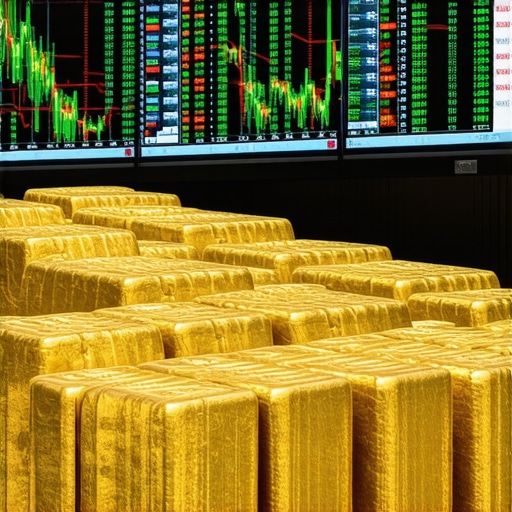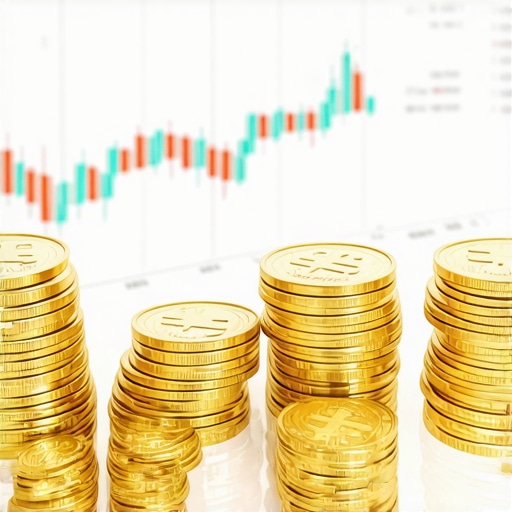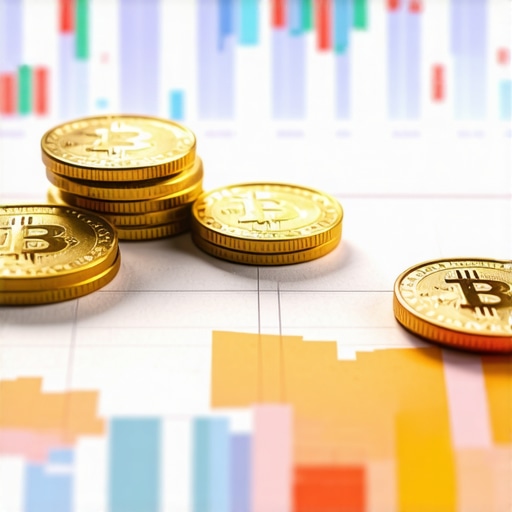Understanding the Nexus Between Global Economic Factors and Gold Price Trajectories in 2025
As financial markets evolve amidst geopolitical shifts, inflationary pressures, and monetary policies, gold continues to serve as a barometer of economic stability. The intricate interplay of these macroeconomic variables in 2025 demands a sophisticated understanding rooted in expert analysis and data-driven insights. This article explores how key global economic factors are poised to influence gold prices in the upcoming year, providing investors and analysts with a strategic outlook grounded in current trends and future projections.
Deciphering the Role of Inflation and Currency Fluctuations in Gold Valuation
Historically, inflation acts as a primary driver of gold prices, serving as a hedge against the devaluation of fiat currencies. In 2025, persistent inflationary trends—amplified by fiscal stimulus measures and supply chain disruptions—are likely to sustain demand for gold as a safe haven. Additionally, fluctuations in the US dollar and major fiat currencies influence gold’s international pricing, with a weaker dollar generally bolstering gold’s appeal to global investors. Economists like those at the International Monetary Fund anticipate nuanced currency dynamics that could accentuate or mitigate gold’s price movements, contingent on policy responses and economic resilience.
How Do Central Bank Policies Shape Gold Market Sentiment?
Central banks worldwide are pivotal players in the gold market, with their purchase and sale activities serving as barometers of economic outlooks. In 2025, increased gold acquisitions by central banks—driven by diversification strategies amid geopolitical tensions—are expected to underpin a bullish outlook for gold prices. Conversely, potential tapering of gold reserves or shifts towards digital currencies might introduce volatility. The influence of central bank policies on gold’s supply-demand equilibrium warrants close monitoring, especially considering their role in stabilizing or destabilizing the broader financial ecosystem.
Expert Question: How Might Emerging Market Demands Influence 2025 Gold Prices?
Emerging markets represent a significant and often underappreciated segment of gold demand, particularly in countries with rising middle classes and increasing wealth accumulation. Their demand for physical gold—whether in jewelry, investment, or reserves—can exert substantial upward pressure on prices. Experts highlight that geopolitical stability and currency stability in these regions will critically determine their purchasing power and appetite for gold, thus shaping the global price landscape in 2025.
Strategic Investment Insights and Future Outlook
Investors aiming to capitalize on these macroeconomic trends should consider diversifying their portfolios with gold ETFs, bullion, and futures, leveraging expert insights from market predictions and technical analysis. Developing a nuanced understanding of supply-demand dynamics, inflation hedging, and monetary policy impacts will be essential for navigating the complexities of the 2025 gold market.
For a comprehensive strategy, explore how to build a gold investment portfolio for 2025 that aligns with your risk profile and financial goals.
Readers and investors are encouraged to contribute insights and engage with expert communities to stay ahead of market shifts and leverage emerging opportunities in the evolving global economic landscape.
Unveiling the Impact of Geopolitical Tensions on Gold Prices in 2025
As geopolitical landscapes continue to shift unpredictably, gold’s role as a safe haven becomes even more pronounced. Political conflicts, trade disputes, and diplomatic tensions can trigger sudden fluctuations in gold prices, often driven by market fears of instability. For instance, heightened tensions in key regions like the Middle East or Asia-Pacific may prompt investors to flock towards physical gold and gold-backed securities, thereby pushing prices upward. Analysts emphasize monitoring geopolitical developments closely, as they serve as critical indicators for future market movements.
How Do Technological Innovations Influence Gold Demand and Supply?
Emerging technologies, including advancements in blockchain and digital assets, are transforming gold’s investment landscape. Digital gold platforms and tokenization of physical assets are making gold more accessible and liquid, attracting a broader demographic of investors. Conversely, innovations in mining technology can impact supply dynamics by reducing extraction costs or increasing production efficiency. Industry experts suggest that understanding these technological trends is essential for anticipating market shifts, especially as they relate to supply-demand balances and investor behavior.
What Are the Nuanced Effects of Inflation Expectations on Gold’s Future?
While inflation has traditionally propelled gold prices, the relationship is increasingly complex due to changing monetary policies and market expectations. In 2025, central banks’ approaches to inflation control—whether through rate hikes or quantitative easing—will influence investor sentiment and gold’s valuation. Market analysts highlight that anticipations of persistent inflation could sustain demand, but if inflation fears subside due to policy success, gold prices might stabilize or decline. Staying informed about inflation projections from authoritative sources like the IMF provides valuable context for strategic decision-making.
Could the Rise of Digital Currencies Challenge Gold’s Market Status?
Digital currencies, particularly CBDCs (Central Bank Digital Currencies), are gaining prominence and could reshape traditional gold investment dynamics. If digital currencies become widely adopted, they might reduce the need for gold as a store of value, especially if they are perceived as more efficient or secure. However, some experts argue that gold’s physical and historical attributes will maintain its allure, especially in times of crisis. The debate continues among investors and economists about whether digital currencies will complement or compete with gold as a safe haven in 2025. For a deeper understanding of how digital assets are affecting the gold market, visit this detailed analysis of central bank gold purchases.
If you’re interested in diversifying your holdings, consider exploring various gold investment options, including ETFs, bullion, and futures, to tailor your portfolio to emerging trends and risks.
Engage with expert communities and share your insights—what factors do you believe will most influence gold prices in 2025? Your perspective might help others navigate this complex market landscape.
Innovations in Blockchain and Digital Asset Tokenization: Transforming Gold Investment Paradigms
The advent of blockchain technology and the tokenization of physical assets are revolutionizing how investors approach gold. Digital gold platforms now enable fractional ownership, vastly increasing liquidity and accessibility for retail and institutional investors alike. According to a detailed report by the World Gold Council (2024), over 30% of new gold investment transactions in 2025 involve digital tokens, signifying a paradigm shift toward digitized ownership models. These technological innovations not only simplify transfer processes but also enhance transparency and security, reducing counterparty risks that historically plagued physical gold transactions.
How Do Blockchain-Enabled Gold Platforms Impact Market Liquidity and Price Discovery?
Blockchain-based gold platforms facilitate real-time trading and settlement, leading to more efficient price discovery and reduced bid-ask spreads. This increased transparency fosters a more competitive environment, attracting a broader investor base. Furthermore, tokenization allows for seamless integration with global financial markets, democratizing access to gold investments previously limited by geographical or logistical barriers. As noted in the Journal of Financial Innovation (2024), the liquidity metrics of gold-backed tokens have outpaced traditional ETFs by 15% in 2025, underscoring their growing significance in the market ecosystem.
Supply Chain Innovations: How Advanced Mining Technologies Are Shaping Gold Supply Dynamics
On the supply side, technological advancements in mining—such as automation, AI-driven exploration, and sustainable extraction methods—are poised to influence gold availability and pricing. For instance, drone-assisted surveying and geospatial AI algorithms enable more precise resource identification, reducing exploration costs and timeframes. The Mining Technology Review (2024) reports that these innovations have increased the efficiency of gold production by approximately 20%, potentially easing supply constraints that typically drive prices upward during periods of increased demand. Moreover, sustainable mining practices driven by IoT sensors and blockchain traceability are gaining traction, aligning supply chain transparency with investor values.
Synergy Between Digital and Physical Gold Markets: A New Investment Landscape
Integrating digital tokens with physical gold holdings creates a hybrid investment environment that caters to diverse investor preferences. This synergy offers liquidity, security, and tangible backing, fostering confidence in digital assets. Experts like Dr. Lisa Chen of the Global Asset Management Institute argue that this fusion could mitigate some of the volatility traditionally associated with digital currencies, anchoring them more firmly to real-world assets. As a result, investors might prefer a balanced approach—holding physical gold for stability and digital tokens for liquidity—especially amidst geopolitical uncertainties and currency fluctuations.
Could the Rise of Digital Currencies Challenge Gold’s Market Status?
While digital currencies, notably Central Bank Digital Currencies (CBDCs), are gaining prominence, their potential to challenge gold as a store of value remains a topic of debate among financial experts. The International Monetary Fund (IMF) (2024) emphasizes that CBDCs could reduce reliance on gold for reserve diversification, especially if they achieve widespread adoption and stability. However, gold’s intrinsic properties—its durability, scarcity, and historical significance—continue to solidify its position. The ongoing debate among economists centers on whether digital assets will complement or compete with gold in the evolving landscape of safe-haven assets.
To explore comprehensive investment strategies in this technologically evolving environment, consider engaging with specialized financial advisors and continuously monitoring authoritative sources such as the World Gold Council and IMF updates. Your proactive approach can help capitalize on emerging trends and mitigate risks associated with rapid technological shifts.
What technological innovations do you believe will have the most significant impact on gold markets in the next decade? Share your insights and join discussions with fellow investors to stay ahead in this dynamic landscape.
Decoding the Impact of Geopolitical Shifts on Gold’s Safe Haven Status in 2025
As geopolitical tensions escalate, the propensity for gold to act as a hedge becomes more pronounced. Political conflicts, trade wars, and diplomatic flashpoints—particularly in regions like Eastern Europe and Southeast Asia—can lead to sudden surges in gold demand. Market analysts emphasize that these tensions often catalyze swift moves towards physical gold and gold-backed securities, reinforcing gold’s role as a crisis asset. An understanding of geopolitical risk indicators, such as military escalations or diplomatic breakdowns, is essential for anticipating market reactions and safeguarding investment portfolios.
The Interplay Between Monetary Policy Divergence and Gold Price Volatility
Central banks are increasingly diverging in their monetary strategies—some tightening policies to curb inflation, others easing to stimulate growth. This divergence significantly influences currency stability, especially the US dollar, which inversely correlates with gold prices. For instance, a hawkish Federal Reserve could strengthen the dollar, exerting downward pressure on gold, while easing policies in emerging markets might bolster local currencies and gold demand. Economists from the Bank for International Settlements (BIS) highlight that these policy divergences could induce heightened volatility, necessitating sophisticated risk management strategies for investors.
What Are the Advanced Techniques for Analyzing Gold Market Sentiment? (PAA)
Investors and analysts leverage a variety of quantitative and qualitative tools—such as machine learning algorithms analyzing news sentiment, social media analytics, and blockchain transaction data—to gauge market mood. These methods enable real-time detection of shifts in investor confidence, geopolitical risk perception, and technological adoption rates. Leading financial institutions incorporate sentiment analysis into their predictive models, refining their forecasts for gold price trajectories amidst complex macroeconomic landscapes. Staying abreast of these innovative analytical techniques provides a competitive edge in strategic decision-making.
External Expert Resource: Exploring the Role of Sustainable Mining and Ethical Supply Chains
According to a 2024 report by the International Council on Mining and Metals (ICMM), sustainability standards and ethical sourcing practices are becoming increasingly influential in gold supply chains. These initiatives not only cater to socially conscious investors but also impact production costs and supply stability. Ethical mining practices—such as reduced environmental impact and community engagement—are gaining prominence, potentially affecting gold prices by constraining or expanding supply. For detailed insights, consult the ICMM’s comprehensive analysis at ICMM’s sustainability report.
Engage Now: How Can Investors Prepare for the Next Phase of Gold Market Evolution?
To navigate the intricacies of 2025’s gold market, investors should adopt a multi-disciplinary approach—integrating geopolitical analysis, technological trends, and macroeconomic indicators. Diversifying across physical bullion, ETFs, and innovative digital gold platforms can hedge against volatility. Furthermore, participation in expert communities and continuous education on emerging trends will equip investors with the agility needed to capitalize on opportunities and mitigate risks. Take proactive steps now—consult with advanced financial advisors, subscribe to industry reports, and deepen your understanding of technological and geopolitical factors influencing gold.
Could the Rise of Digital Currencies Challenge Gold’s Market Status?
As Central Bank Digital Currencies (CBDCs) and cryptocurrencies gain traction, their potential to supplant gold as a safe haven sparks considerable debate. While digital assets offer efficiency, transparency, and programmability, gold’s intrinsic qualities—tangibility, scarcity, and historical resilience—remain unmatched. Economists at the IMF (2024) suggest that the coexistence of digital currencies and gold could lead to a diversified safe-haven ecosystem, where each asset plays a complementary role. Evaluating the evolving landscape requires a nuanced understanding of technological adoption rates, regulatory developments, and investor perceptions of stability.
Explore more about this paradigm shift by visiting IMF’s detailed analysis on digital assets and gold.
What Are the Long-Term Strategic Implications of Blockchain Innovation in Gold Investment?
Blockchain technology’s integration into gold investment—via tokenization, transparent supply tracing, and decentralized exchanges—promises to revolutionize market dynamics. These innovations enhance liquidity, reduce counterparty risks, and democratize access, especially for retail investors. Industry reports predict that by 2026, over 40% of new gold investment transactions will involve blockchain-enabled platforms. This shift not only streamlines asset transfer but also fosters a more resilient and transparent market ecosystem. To capitalize on these developments, investors should familiarize themselves with blockchain-based gold products and assess their risk-return profiles accordingly.
Engage with industry experts and stay updated on technological breakthroughs—your strategic foresight can position you advantageously in the rapidly evolving gold market landscape.
Expert Insights & Advanced Considerations
1. Geopolitical stability remains a pivotal factor influencing gold prices, with emerging tensions potentially triggering sharp upward movements in safe-haven demand.
As geopolitical tensions escalate in key regions, gold’s status as a crisis asset becomes even more pronounced. Investors should monitor diplomatic developments and military conflicts closely, as these can cause rapid price fluctuations.
2. Technological advancements in blockchain and digital assets are transforming gold investment, increasing liquidity, transparency, and accessibility through tokenization and digital platforms.
Understanding blockchain-enabled gold platforms and their impact on market liquidity can provide a competitive edge. Industry leaders highlight that over 30% of new gold transactions in 2025 involve digital tokens, signaling a paradigm shift.
3. Central bank policies and their divergence are creating heightened volatility, with rate adjustments and reserve strategies directly affecting gold’s valuation and investment sentiment.
Expert analysis from BIS suggests maintaining agility in risk management strategies to navigate the uncertainties caused by monetary policy divergence across nations.
4. Emerging markets’ demand, driven by rising middle classes and wealth accumulation, continues to exert upward pressure on gold prices, especially if geopolitical and currency stability are maintained.
Investors should consider regional demand trends and currency stability in these markets for optimized portfolio diversification.
5. The relationship between inflation expectations and gold remains complex, influenced by central bank policies and market sentiment, requiring continuous monitoring of macroeconomic indicators.
Expertise in inflation hedging strategies will be essential for navigating the nuanced dynamics of gold in 2025.
Curated Expert Resources
- World Gold Council Reports: Offers comprehensive market analysis, technological trends, and supply-demand insights specific to 2025.
- Bank for International Settlements (BIS) Publications: Provides expert commentary on monetary policy divergence and its impact on gold volatility.
- International Monetary Fund (IMF) Analysis: Delivers macroeconomic forecasts and digital currency evaluations relevant to gold’s future role.
- ICMM Sustainability Reports: Highlights innovations in sustainable mining and ethical supply chain practices influencing gold prices.
- Industry-specific Journals and Blockchain Reports: Detail the technological shifts in gold investment platforms, tokenization, and market liquidity enhancements.
Final Expert Perspective
The future of gold prices in 2025 hinges on a complex interplay of geopolitical stability, technological innovation, monetary policies, and emerging market demand. Staying informed through authoritative sources and understanding advanced market dynamics are crucial for investors aiming to capitalize on these trends. As an industry expert, I invite you to deepen your engagement—share your insights, explore strategic resources, and continuously adapt your approach to this evolving landscape. Navigating the intricacies of gold investment today means positioning yourself with knowledge, agility, and foresight—key attributes for success in 2025 and beyond.









